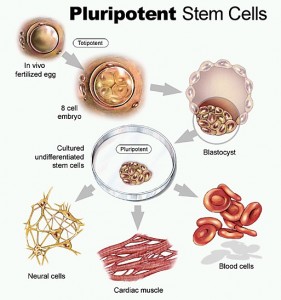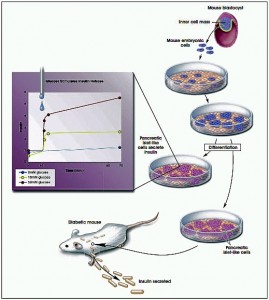
20th November 2009 : Written by Jihan Noor for Biomedme.com – Embryonic stem cell research has been one of the most debated and controversial issues in recent times.It is claimed that the use of embryonic stem cells has the potential to revolutionize the future of medicine with the ability to regenerate damaged and diseased organs.It offers unprecedented hope in treating many delibitating diseases like Parkinsons disease,heart infractions,cancer and immune diseases,diabetes etc.On the other hand it has been highly controversial due to the ethical issues concerned over the culture and use of stem cells derived from human embryos.In January 2009,the first clinical trial using embryonic stem cell in humans was approved by the U.S Food and Drug Administration(FDA).A biotech company called the Geron corporation will be conducting the trial.The study will involve the injection of neural stem cells into paraplegics who have suffered a recent spinal cord injury.Researchers believe that restoration of myelin sheath and an increased mobility is possible.This could lead to future studies that involve people with more severe disabilities.
Characteristics of embryonic stem cells.
Embryonic stem cells are distinguished by two distinctive properties:
- Pluripotency that is their ability to differentiate into all derivatives of the three primary germ layers:ectoderm,endoderm and mesoderm.These include more than 220 cell types in the human body.
2.Another is their capacity to self renew themselves.This makes them useful tools in regenerative medicine.
Brief history of embryonic stem cell research.
- In 1981,ES cells were first derived from mouse embryos by Martin Evans and Matthew Kaufman at the department of Genetics,university of Cambridge and independantly by Gail R.Martin.Martin is credited with coining the term”embryonic stem cell”.
- In 1998,a breakthrough occurred when researchers led by James Thompson at the university of Wisconsin,Madison,first isolated and grew human ES cells in cultures.
Technique.
 ES cells are derived from embryos that develop from eggs of invitro fertilization.The embryos are usually got from IVF clinics with the consent of donors.The embryos used are typically four to five days old and are a hollow ball of cells called blastocyst.The blastocyst consists of a hollow cavity called the blastocoel which is surrounded by a cell layer called trophoblast.There are a group of cells at one end of the blastocoel called inner cell mass.
ES cells are derived from embryos that develop from eggs of invitro fertilization.The embryos are usually got from IVF clinics with the consent of donors.The embryos used are typically four to five days old and are a hollow ball of cells called blastocyst.The blastocyst consists of a hollow cavity called the blastocoel which is surrounded by a cell layer called trophoblast.There are a group of cells at one end of the blastocoel called inner cell mass.
Human ES cells are obtained by transfering this inner cell mass to a culture medium containing a feeder layer(irradiated mouse fibroblast cells) and allowed to divide and multiply.There have been recent reports of ES cells cultured on feeder cell free medium.Es cells can be induced to differentiate by culturing in suspension to form three dimentional cell aggregates called embryoid bodies(Ebs).
The addition of certain growth factors to these cultures promotes cells to spontaneously differentiate into various cell types eg.neurons,cardiomyocytes,pancreat-ic beta cells etc.
Promises of embryonic stem cell research.
ES cells play a very important role in functional genomic studies,study of biological processes,drug discovery and development.But the most prominent use is in the treatment of various intractable diseases such as :
Parkinsons disease.
This is a neurodegenerative disease caused when 80% or more of dopamine producing neurons in the substantia nigra of the brain die.
Researchers from Kyoto university in 2005 have generated dopamin producing neurons from monkey embyonic stem cells.These when transplanted into areas of the brain where these neurons have degenerated in a monkey model of parkinsons disease,reversed parkinsonism.
Heart disease.
The high rate of mortality associated with heart diseases is the inability to repair damaged tissue due to full differentiation of the heart tissue.Interruption of blood supply to the tissue causes infraction of myocardium and death of myocardiocytes.
A recent report used a swine model of atrioventricular block and transplanted human ES cell-derived cardiomyocytes into the pigs heart to work as a pacemaker.The ES cells survived,functioned and integrated well with the host cells.
Diabetes.
 Type I diabetes or juvenile onset diabetes,is an autoimmune disease that causes destruction of insulin producing beta cells in the pancrease.
Type I diabetes or juvenile onset diabetes,is an autoimmune disease that causes destruction of insulin producing beta cells in the pancrease.
In 2008,scientists at the biotech company Novocell have shown that human embryonic cells can be coaxed into differentiating into insulin producing beta cells.These when transplanted into diabetic mice were able to normalise glycemia.
Cancer.
Stem cell researchers at the university of Minnesota have coaxed human ES cells to generate natural killer cells.NK cells are normally present in the blood stream and helps defend body against infection and cancer.NK cells produced by this way were found capable of destroying certain human cancer cells invitro .
Challenges
One of the hurdles in the use of ES cells is the immunological rejection of transplanted cells.However these problems of histocompatibility maybe solved using autologous donor adult stem cells or via therapeutic cloning .Therapeutic cloning involves somatic cell nuclear transfer where patients DNA is injected into an enucleated unfertilized egg and used to generate ES cells which are then cultured and allowed to differentiate followed by transplantation into patient.
Researchers are also trying to solve the ethical issue over the use of human embyos by using an alternative method called Induced Pluripotent stem cell technology.In this technique differentiated cells such as human skin cells are reprogrammed into pluripotent stem cells by the intoduction of certain genes.
Such cells are called induced pluripotent stem cells.On march 5,2009,Whitehead Institute researchers developed a novel method to remove potential cancer causing genes during reprogramming of skin cells from parkinsons disease patients into embryonic stem cell like state.These iPS cells were then used to derive dopamine producing neurons.This marks the first time researchers have generated human iPS cells that maintain embryonic stem cell like properties after removal of reprogramming genes.
As research on human embryonic stem cells passes the ten year milestone,it is still too premature to say that the outcomes of this research are as successful and positive as it claims to be.There is no doubt that this research could boost medical progress toward eradicating debilitating diseases but technical hurdles remain that will only be overcome through years of intensive research.
